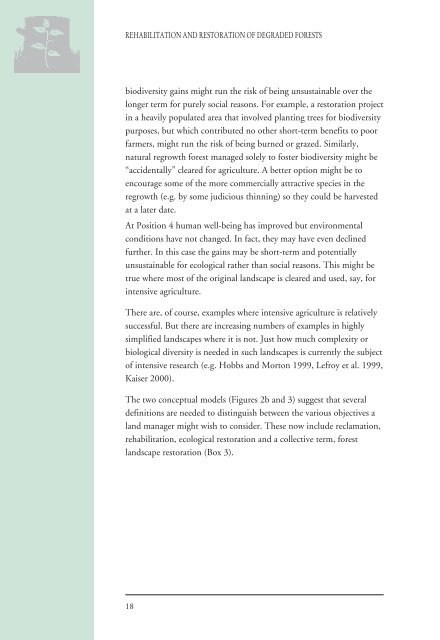Rehabilitation and Restoration Of Degraded Forests (PDF) - IUCN
Rehabilitation and Restoration Of Degraded Forests (PDF) - IUCN
Rehabilitation and Restoration Of Degraded Forests (PDF) - IUCN
You also want an ePaper? Increase the reach of your titles
YUMPU automatically turns print PDFs into web optimized ePapers that Google loves.
REHABILITATION AND RESTORATION OF DEGRADED FORESTS<br />
biodiversity gains might run the risk of being unsustainable over the<br />
longer term for purely social reasons. For example, a restoration project<br />
in a heavily populated area that involved planting trees for biodiversity<br />
purposes, but which contributed no other short-term benefits to poor<br />
farmers, might run the risk of being burned or grazed. Similarly,<br />
natural regrowth forest managed solely to foster biodiversity might be<br />
“accidentally” cleared for agriculture. A better option might be to<br />
encourage some of the more commercially attractive species in the<br />
regrowth (e.g. by some judicious thinning) so they could be harvested<br />
at a later date.<br />
At Position 4 human well-being has improved but environmental<br />
conditions have not changed. In fact, they may have even declined<br />
further. In this case the gains may be short-term <strong>and</strong> potentially<br />
unsustainable for ecological rather than social reasons. This might be<br />
true where most of the original l<strong>and</strong>scape is cleared <strong>and</strong> used, say, for<br />
intensive agriculture.<br />
There are, of course, examples where intensive agriculture is relatively<br />
successful. But there are increasing numbers of examples in highly<br />
simplified l<strong>and</strong>scapes where it is not. Just how much complexity or<br />
biological diversity is needed in such l<strong>and</strong>scapes is currently the subject<br />
of intensive research (e.g. Hobbs <strong>and</strong> Morton 1999, Lefroy et al. 1999,<br />
Kaiser 2000).<br />
The two conceptual models (Figures 2b <strong>and</strong> 3) suggest that several<br />
definitions are needed to distinguish between the various objectives a<br />
l<strong>and</strong> manager might wish to consider. These now include reclamation,<br />
rehabilitation, ecological restoration <strong>and</strong> a collective term, forest<br />
l<strong>and</strong>scape restoration (Box 3).<br />
18

















